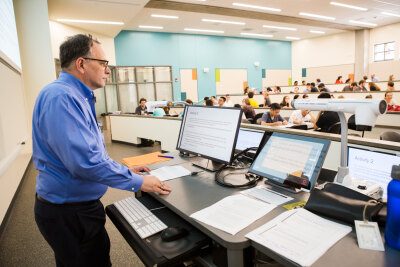
Foundational Concepts Topics
Welcoming Diverse Perspectives and Experiences
Students enter each class with a wealth of information and experiences that relate in a variety of ways to the topics and skills that they will be learning and engaging with, in your course, as well as a variety of ways that they will use course content and skills after the class. In traditional views of education, students come into the classroom with a standard background set of skills, but otherwise as empty vessels waiting for us to fill them with knowledge. But this view has repeatedly been proven to not be the case. While we imagine students taking a specific path through our courses, and we even have very detailed degree plans designed to show students how this might be done, very few students actually go down these paths precisely as planned. Additionally, the knowledge and skills students gain from their previous courses, as well as their variety of life experiences, means that they come to our classroom environment with a wide variety of pre-existing knowledge, skills, experiences, values, and perspectives. Some of these will be directly relevant and valuable in the class, others may be interfere with student success. Even when existing knowledge does not align with the content of the course, learning is most successful when this variety is acknowledged so that students can overcome and make new meaning from this incongruity.
Beyond the content of the course, we strive to find ways to value the diversity students bring to the learning experience and help students make connections with their existing life experiences and goals, to help make our course more meaningful to them. If we want students to retain and integrate new information, one of the most effective means of doing so is in making connections with their existing experiences and future goals.
Valuing diversity is not only between the instructor and individual students, but also creating a collaborative environment in the classroom where students realize the benefits of working together. Having students learn from and with each other in diverse groups has profound benefits for enhancing thinking and innovation (see Rock & Grant, below), but it also supports students’ sense of belonging at the university, which has direct ties to overall persistence.
Practices that support welcoming diverse perspectives and experiences:
Share your own journey: Help students understand that your own work is influenced by your background, and how your experiences help inform your work, interests, and research.
Learn students’ names: Develop a strategy for learning student names when in a class size that accommodates doing so. In larger classes, ask students to share their name when they share an idea and repeat their name in responding. In email correspondence, address students by their names.
Incorporate pauses and opportunities for collaboration and sharing: Pausing is a powerful tool in every class type. In classes where students are already on teams, a pause for reflection can help students process their experience and contributions thus far. In discussion classes, pauses can be valuable for students who may benefit from time to think before they share or encourage those prone to sharing quickly to take time to reflect. In lecture classes, pausing can help students assess their progress thus far, ask questions, provide feedback, and/or have a brief conversation with a neighbor on the topic. For more on pausing, see the Lecturing page.
Module Navigation
- Next Module: Belonging
- Previous Module: Communication
- Current Topic: Foundational Concepts
- Next Topic: Applications in Context
Leave Your Feedback
You must be logged in to post a comment.